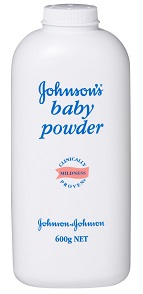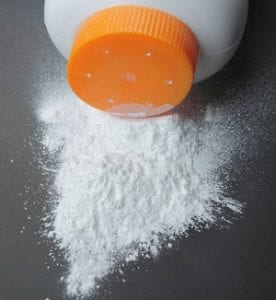 An expert witness for the plaintiff testified Feb. 15, 2016 that talc causes ovarian cancer. Washington University’s Dr. Graham Colditz was on the witness stand all day at the fourth Johnson & Johnson talcum powder cancer trial in St. Louis.
An expert witness for the plaintiff testified Feb. 15, 2016 that talc causes ovarian cancer. Washington University’s Dr. Graham Colditz was on the witness stand all day at the fourth Johnson & Johnson talcum powder cancer trial in St. Louis.Dr. Colditz discussed the body of epidemiological research comparing the cancer rates of talc and non-talc users. The plaintiff is Nora Daniels, a longtime talcum powder user who blames Johnson & Johnson talc for the cancerous tumor she developed and had removed in 2013.
Defense lawyers for J&J objected almost continuously all day as Dr. Colditz testified in regard to studies that found a higher likelihood of ovarian cancer in talc users, and medical agencies that have red flagged talc as a risk.
Talc causes Ovarian Cancer
“What opinion are you here to give today to this jury?” Ms. Daniels’ lawyer asked. Dr. Colditz responded: “At the bottom line, that talc causes ovarian cancer, based on the review of all the evidence.”
Dr. Colditz’ own epidemiology group at Washington University in St. Louis and the Siteman Cancer Center added talc to a website they run which allows people to assess their personal risk levels for certain diseases. He said they did so based on an accumulation of studies.
Misclassification of Talc
The plaintiff’s expert also showed the Nurses’ Health Study, which asked tens of thousands of RNs one question about talc use in 1982, then never mentioned it again in later data collections. Since the data were not accurately and cleanly traced over time, said Dr. Colditz, it was natural that the effect shown by the 1982 data would decay over time due to a known phenomenon in epidemiology called misclassification.
Over time, talc users could have stopped using, and nonusers could have started, but they would remain classified as they were in 1982 for lack of follow-up. However, the study researchers did continue to count the number of cancers contracted in the entire pool over the decades. Therefore, Colditz testified, the baseline cancer rates of users and nonusers would come to appear closer than they actually are over time as more and more people jumped classifications.
Direct examination also showed a July 12, 2006 letter from J&J’s supplier, Imerys Talc America – then known as Luzenac and owned by Rio Tinto – to Mark Ellis, president of the Industrial Minerals Association, in Washington, D.C. The letter revealed that Luzenac decided to abandon funding its own study, which had been set up by a scientific researcher at Crowell & Moring.
This study proposal was first brought to Luzenac’s attention in early 2005 primarily due to the diligent efforts of Bob Glenn,” a Luzenac employee wrote to Ellis. “Luzenac has engaged the consulting services of Bob (through Crowell & Moring) for several years now. Luzenac was prepared to proceed with the study primarily because there was an excellent chance that the study could be completed and a paper written [before] the IARC review in February 2006. We felt that the injection of new data into the talc/ovarian cancer debate was essential.”
But the project was beset by delays, and after it was clear it couldn’t be finished in time to influence IARC, an agency of the World Health Organization, Luzenac abandoned the initiative. IARC ended up classifying perineal talc as a possible carcinogen.
Cross Examination
On cross examination, J&J lawyers showed Colditz one study by the Ovarian Cancer Association Consortium, a survey looking at many studies that altogether included 8,525 cases of the cancer and 9,859 controls with no cancer. It found a “modest increased risk of epithelial ovarian cancer”– the type Ms. Daniels had – but expressed doubts regarding the trend across decades or a lifetime.
J&J attorneys hit Colditz with documents that included recent website printouts from the National Cancer Institute and the National Toxicology Program. According to Law 360, J&J counsel fought to leave the impression that the tide of science is turning against a link.
J&J’s counsel also compared talc to other products: Aloe vera, which IARC also classifies as a possible carcinogen, as well as coffee, which was delisted from that category only recently. Then, J&J brought up the subject of two well-known carcinogens, alcohol and red meat.
No Cancer Warnings for Red Meat or Liquor?
“There’s no cancer warning for alcohol that you might buy at the store, right?” J&J attorneys asked Colditz. “You’ve never seen a warning on red meat, a cancer warning on red meat at the store, have you?”
Colditz conceded he had not, although he said they might exist “on websites that talk about causes.”
The case is Swann v. Johnson & Johnson, case number 1422-CC09326-01, in the 22nd Judicial Circuit of Missouri.
RELATED
- Talcum Powder Cancer Lawsuit
- Talcum Powder $72 Million Trial Verdict
- Talcum-Mesothelioma Cancer Lawsuit

by Matthews & Associates




